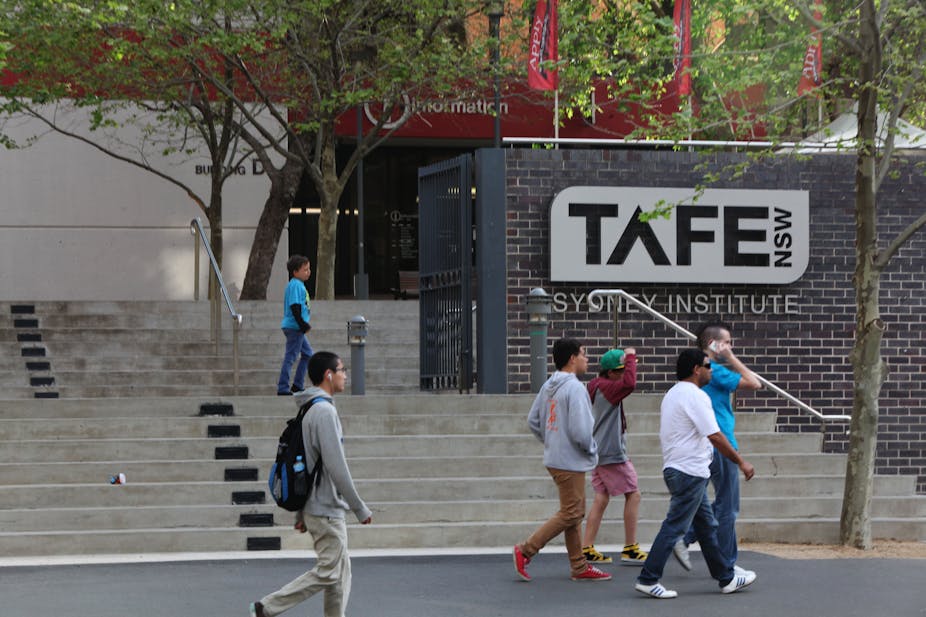Since their inception in 1974, Technical and Further Education (TAFE) institutions have been the major providers of Vocational Education and Training (VET) in Australia. This may not be the case in the future.
Non-TAFE providers have been increasing their market share of public VET funding. Between 2008 and 2012, payments to these providers increased by A$950 million, an increase of more than 200%.
The concept of a training market has long been a policy objective of Australian governments. They began to contract the delivery of training from a range of public, private and industry providers more than 20 years ago. By 1999, government funding for apprenticeships and traineeships was opened up to approved providers in most states. However, until recently TAFE still received the bulk of its public funding through annual agreements with state government VET departments.
TAFE is losing its market share
VET funding is now becoming far more competitive. Under a “student entitlement” model, eligible students select their provider of choice. This links VET revenue directly to student preferences and enrolments. In most states all providers will compete for students from the same pool of money.
Victoria and South Australia have already implemented this model with significant consequences for TAFE. Since 2008 in Victoria TAFE market share of government funded student load has fallen from almost 70% to 45% and in South Australia, it fell from 71% in 2011 to 51% in 2012.
TAFE’s loss of market share in Victoria was exacerbated in 2012 when specific funding to cover the costs of TAFE’s role as a public provider was cut. The cumulative effect of the funding changes has seen a deterioration in the overall financial position of TAFE in that state. Five institutes are rated by the Victorian Auditor General as having a high financial sustainability risk and eight as medium risk – although four institutes also recorded a surplus.
Loss of market share should not be confused with lower enrolments. In both states – particularly Victoria – TAFE enrolments actually grew as the system expanded but at a far lower rate than private providers.
The other states are now implementing the entitlement system but without funding growth. They are restricting funding to specific courses, many in areas of existing TAFE provision. If the Victorian and South Australian experience is repeated, TAFE will also lose market share in those states but without the advantages of a growing VET system.
Why has TAFE lost market share?
Given the expanding system, why has TAFE lost market share? What does this mean for the future of TAFE?
We often hear that TAFE has lost market share because of “dodgy” private providers who run cheap quick courses with low standards, or because TAFE is an inflexible high cost provider ill-suited to a competitive environment.
In fact the possible reasons for the loss of TAFE market share are complex and varied. Some of these reasons are that:
in any new market existing long-standing providers often lose market share to new providers who are able to pick and choose what areas of the market they wish to enter and design their business models around the new rather than the old system;
in Victoria at least, many institutes were slow to plan for the new system. In particular, they were slow to adjust their marketing and offerings to new markets created under the entitlement model;
private providers have more flexible and lower-cost delivery models – many with minimal infrastructure and facilities, and high levels of casual and contract staff. Most TAFEs operate as “full service” providers seeking to maintain broad subject areas and a more intensive delivery and student support model. This is a particular problem when low cost providers opt to not charge student fees at all, placing TAFE at a price disadvantage; and
some providers have exploited significant weaknesses in the design of the entitlement model, leading to major blow-outs in enrolments in specific course areas.
The future of TAFE
It is essential that the reasons for the loss of TAFE market share are analysed and understood at the institutional level and by government as the owner.
Governments must be clearer about the role and purpose of TAFE as the public VET provider in a competitive system, recognising that a largely government-funded private training market alone will not provide the depth, breadth or ongoing capacity required to meet Australia’s workforce skills needs into the 21st century. Skills supply cannot be just turned off and on like a tap.
One thing is clear: student-driven and demand-based funding is here to stay in both the VET and higher education sectors. The future of TAFE is not to be found in a return to a public monopoly that has not existed for over 20 years, as some have proposed. Rather, the TAFE business and delivery model must be much more strongly attuned to the needs of the hundreds of thousands of potential students who are eligible for the VET student entitlement – even with its design faults.
TAFE’s future will also not be found in just seeking to re-build market share but as a distinctive, high quality and flexible provider with a relentless commitment to student and industry engagement competitive in all of the markets in which it operates.

